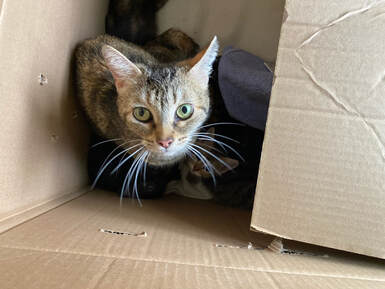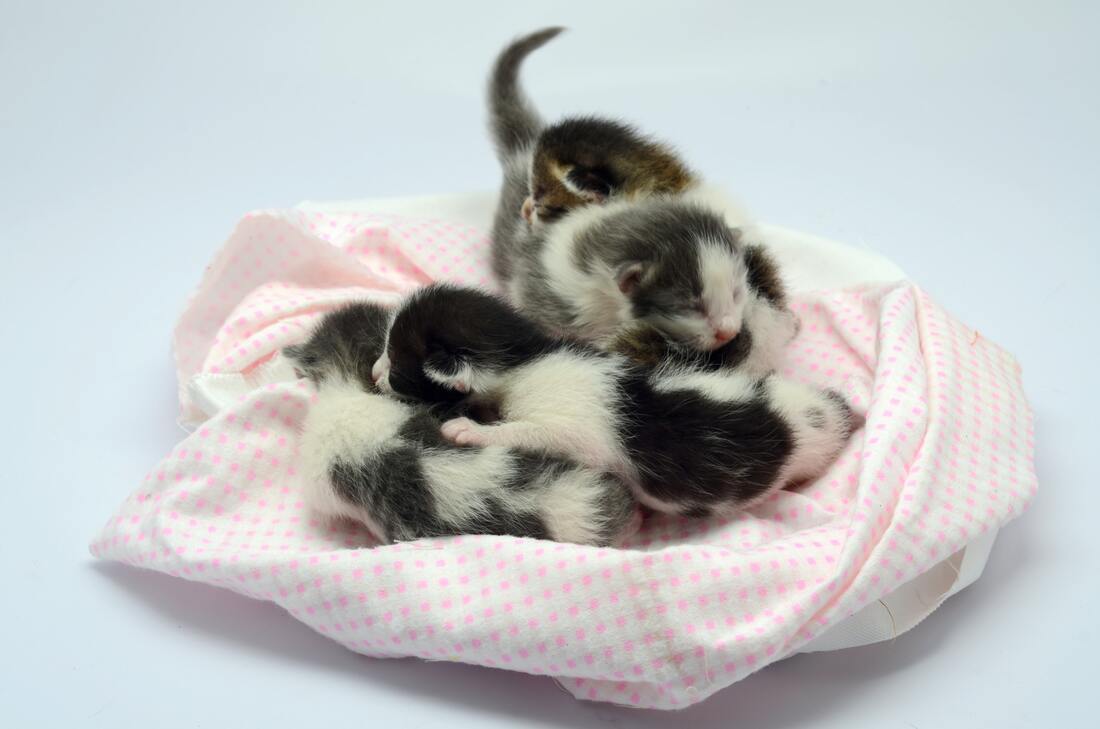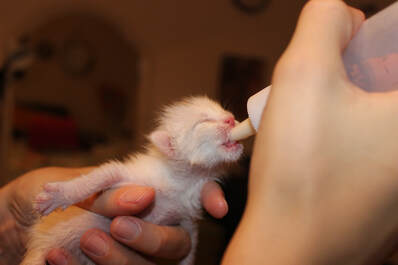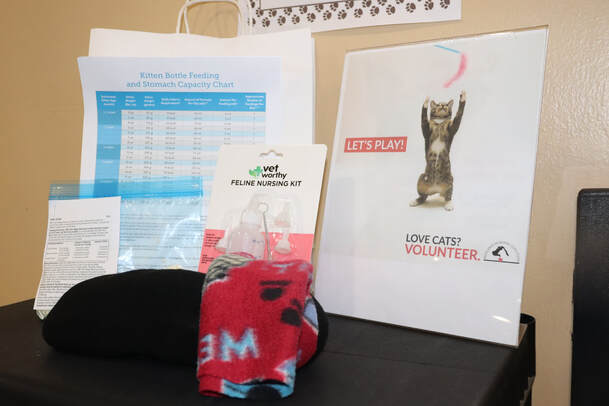Kitten Care Guide
HOW TO TAKE CARE OF ABANDONED/ORPHANED NEWBORN KITTENS
 This momma cat & six kittens were rescued by a concerned citizen minutes after they were dumped at a Midland park.
This momma cat & six kittens were rescued by a concerned citizen minutes after they were dumped at a Midland park.
Sometimes kittens find themselves abandoned or orphaned when their mother has died, become ill/injured or rejected them. When this happens, their survival rests entirely on human intervention and would need to be hand raised.
Picking up the litter
When you’ve taken the step to collect these kittens, make sure you transport them safely in a box or carrier covered with blankets/towels to keep them warm as they are unable to regulate their body temperature and chill quickly. Use heating pads when available. Alternatively, you may make your own heating rice bags.
STEP 1 - See a Vet
If possible, take the kitten to a veterinarian to be checked for their general condition and for signs of dehydration. Kittens can become dehydrated rapidly without their mother - through lack of fluids or diarrhea. Dehydrated kittens have very little energy and appetite and may require fluids under their skin immediately. Stools should be checked for worms and parasites.
Also, ask your vet about testing for FIV/FELV, starting a vaccine series, and spaying/neutering at the appropriate age (vets vary on this).
Your vet will be able to determine the kitten’s age, which is crucial to determining appropriate feeding, handling and training they require. Your vet will also be the perfect source for supplies and advice on how to hand-raise kittens.
HOW TO DETERMINE A KITTEN’S AGE
The best way to determine the age of a kitten is to take it to a veterinarian for an assessment. Until you can take them in, you may need to estimate their age:
Consider the following signs:
- Newborn to 2 Weeks old - The kitten's eyes are closed until day 10. The ears are folded over. The kitten doesn't walk; instead, he crawls and wriggles.
- 2 Weeks to 3 Weeks old - The kitten's eyes are open, but his ears are still folded over. The kitten is starting to walk, but he's unsteady and wobbly.
- 3 Weeks to 4 Weeks old - The kitten can walk well; he's no longer wobbly. His ears are unfolding into an erect position. He's beginning to experiment with soft solid foods during week 4.
- 4 Weeks to 5 Weeks old - Some kittens begin learning how to run during the latter part of week 5 and nearly all run by the end of week 6.
|
STEP 2 - Provide Warmth & a Safe Place
Once you get the kitten home, it’s crucial to provide them with constant warmth and a secure area. Kittens cannot regulate their body temperature and will chill very quickly. Find a spot in your home that is warm, draft-free and isolated. Keep the area secure from other pets and young children. Kittens should be kept in a cat carrier/cardboard box wrapped in a few layers of towels/blankets. As soon as possible, get them on top of a heating pad. Put the heating pad in one side of the box or carrier so they can crawl off if they get too hot. Don’t forget to put a towel or blanket over the heating pad. Do not attempt to feed a cold kitten - wait until she warms up. |
STEP 3 - Feeding (Bottle Feeding & Weaning)
WHAT TO FEED
Under 4 weeks - Bottle Feeding
Kittens under 4 weeks cannot eat solid food. They rely on their mother’s milk. However, when that is not an option, you can use a kitten milk replacer.
We use the Petag KMR Kitten Milk Replacer formula in our kitten kits. Please do NOT use cow’s milk — it does not contain the proper nutrients that kittens need and can be harmful.
If in doubt, follow the manufacturer's instructions on how much the kitten should be eating as every formula has different caloric content.
Over 4 weeks - Weaning
By 4 weeks, you can start weaning them off of the bottle and started on solid food. Canned kitten food can be mixed with the milk replacer to create a gruel. You can buy dry/canned food made specifically for weaning kittens.
Weaning is a gradual and often messy process that takes time and practice. Here’s an example of what this process could look like:
If the kitten doesn’t take to the spoon or the saucer right away, you can continue to offer the bottle.
As you progress through the weaning process, monitor your kitten and their stool to ensure that they digest everything well.
If your kitten is doing well and isn’t experiencing digestive issues (like loose stool or diarrhea), then you can gradually introduce more and more food. Let the kitten eat until full, you’ll know when they turn their head away.
At this stage, it’s also important to offer your kitten a bowl of fresh water to make sure that they’re staying hydrated.
Here is a helpful video to guide you: Weaning orphaned kittens to solid food
By 4 weeks, you can start weaning them off of the bottle and started on solid food. Canned kitten food can be mixed with the milk replacer to create a gruel. You can buy dry/canned food made specifically for weaning kittens.
Weaning is a gradual and often messy process that takes time and practice. Here’s an example of what this process could look like:
- Start by offering the kitten formula on a spoon to encourage them to taste it.
- Next, start offering the kitten formula in a saucer.
- Gradually add canned food to the kitten formula in the saucer.
- Increase the canned food in the saucer while reducing kitten formula.
If the kitten doesn’t take to the spoon or the saucer right away, you can continue to offer the bottle.
As you progress through the weaning process, monitor your kitten and their stool to ensure that they digest everything well.
If your kitten is doing well and isn’t experiencing digestive issues (like loose stool or diarrhea), then you can gradually introduce more and more food. Let the kitten eat until full, you’ll know when they turn their head away.
At this stage, it’s also important to offer your kitten a bowl of fresh water to make sure that they’re staying hydrated.
Here is a helpful video to guide you: Weaning orphaned kittens to solid food
HOW MUCH & HOW OFTEN TO FEED
The frequency that your kitten eats normally depends on how old they are:
- Under 2 weeks old: every 2-3 hours
- 3 weeks old: every 3-4 hours.
- 6 weeks old: three or more feedings of canned food spaced out evenly throughout the day
- 12 weeks old: three feedings of canned food spaced out evenly throughout the day
You can also refer to this detailed Kitten Bottle Feeding & Stomach Capacity Chart
|
FEEDING METHOD
Here is a helpful video to guide you: How to Bottle Feed an Orphaned Kitten |
***If you have any feeding issues or if the kitten refuses to eat, please see a veterinarian.***
STEP 4 - STIMULATION ELIMINATION (Going potty)
Kittens under 4 weeks need to be stimulated to defecate and urinate. The mother cat would stimulate the kitten’s bowels and abdomen by licking kitten as if to clean them.
Alternatively, a surrogate cat mom should gently rub the kitten's abdomen, genital and anal area with a clean, warm and wet cotton ball. This stimulates the discharge of waste allowing the kitten to go to the bathroom within a minute. After the kitten is done, clean them carefully with a soft wet cloth or baby wipes. This should be done after every feeding.
Here is a helpful video to guide you: Stimulating Elimination in Orphan Kittens
Kittens under 4 weeks need to be stimulated to defecate and urinate. The mother cat would stimulate the kitten’s bowels and abdomen by licking kitten as if to clean them.
Alternatively, a surrogate cat mom should gently rub the kitten's abdomen, genital and anal area with a clean, warm and wet cotton ball. This stimulates the discharge of waste allowing the kitten to go to the bathroom within a minute. After the kitten is done, clean them carefully with a soft wet cloth or baby wipes. This should be done after every feeding.
Here is a helpful video to guide you: Stimulating Elimination in Orphan Kittens
STEP 5 - LITTER BOX TRAINING
Once the kitten is 3-4 weeks old, you can slowly introduce them to the litter box. You can stimulate them with a cotton ball while inside the litter box to help them understand what to do.
A small, cardboard box (like the type used for canned kitten food) works well. Do not use regular clumping litter as the kitten might try to eat the litter. There is a brand of litter made to litter box train kittens called Kitten Attract.
Once the kitten is 3-4 weeks old, you can slowly introduce them to the litter box. You can stimulate them with a cotton ball while inside the litter box to help them understand what to do.
A small, cardboard box (like the type used for canned kitten food) works well. Do not use regular clumping litter as the kitten might try to eat the litter. There is a brand of litter made to litter box train kittens called Kitten Attract.
Kitten Care Kit
|
When you decide to help kittens, here are some of the necessities. It's best to be prepared and have these items on hand.
Must-haves:
|
Other things you may need :
- One 3-cc syringe for feeding (without needle) Syringes help kittens who are too ill to suck on a bottle, and when feeding a blend of formula and wet food.
- Canned kitten food. This can be mixed with formula to help wean kittens on to more solid food. Choose a kitten specific formula in your favorite brand.
- Puppy pads
- Cotton balls, wet wipes for stimulation and clean-up
- Shallow box/Foil pan - for litter box. A small, shallow pan helps small kittens access the litter.
- Kitty litter. Non-clumping litter is best. There are kitty litter specifically made for young kittens.
KITTEN MILESTONES
Day 1: a kitten should weigh 2 to 4 ounces.
Day 7: it should double in body weight.
Day 8: The kitten should open its eyes. The eyes will stay blue for about 2 more weeks. (The true eye color will not appear until the kitten is about 3 months old.)
Week 2: The ears will start to stand up.
Week 3: The kitten will try to walk.
Week 4: The kitten will start to play with littermates and develop teeth.
Week 6: Most veterinarians will give the first shot at 6 weeks old. Check with your veterinarian as to the timing of the needed vaccinations.
Week 8: The kitten should be ready for adoption at 8 weeks, and should be spayed or neutered at that time.
Day 1: a kitten should weigh 2 to 4 ounces.
Day 7: it should double in body weight.
Day 8: The kitten should open its eyes. The eyes will stay blue for about 2 more weeks. (The true eye color will not appear until the kitten is about 3 months old.)
Week 2: The ears will start to stand up.
Week 3: The kitten will try to walk.
Week 4: The kitten will start to play with littermates and develop teeth.
Week 6: Most veterinarians will give the first shot at 6 weeks old. Check with your veterinarian as to the timing of the needed vaccinations.
Week 8: The kitten should be ready for adoption at 8 weeks, and should be spayed or neutered at that time.




